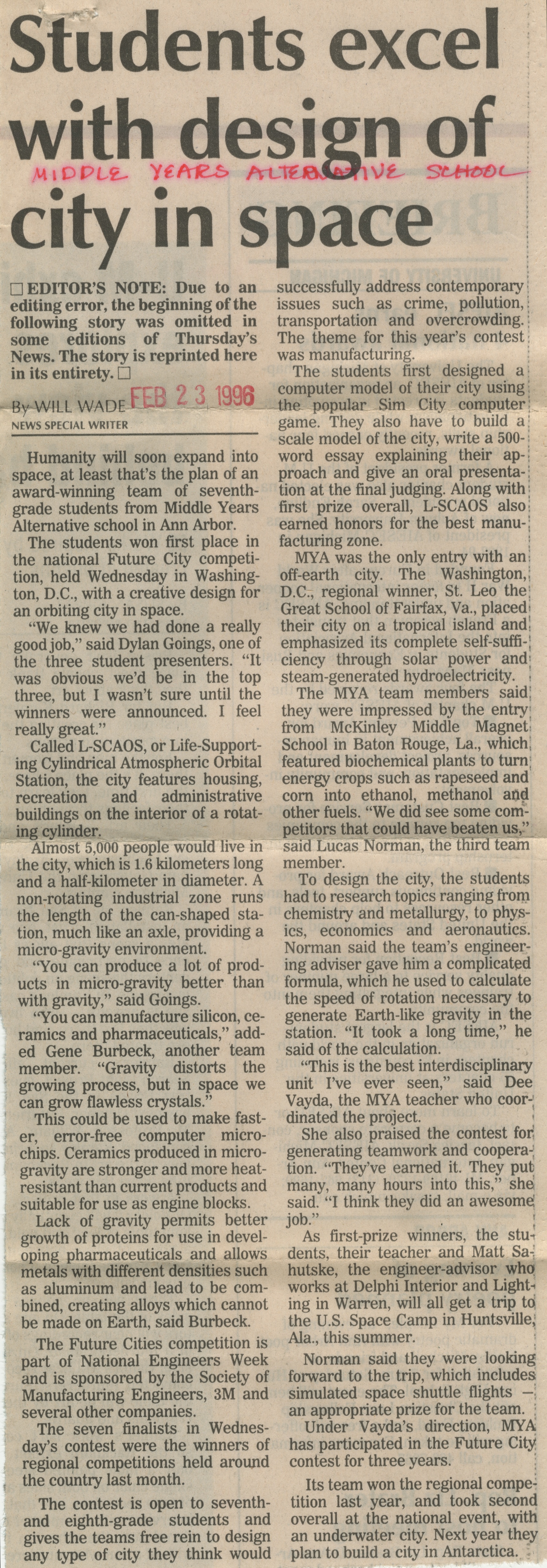Students Excel With Design Of City In Space

Students excel with design of city in space
□ EDITOR’S NOTE: Due to an editing error, the beginning of the following story was omitted in some editions of Thursday’s News. The story is reprinted here in its entirety.
By WILL WADE
NEWS SPECIAL WRITER
Humanity will soon expand into space, at least that’s the plan of an award-winning team of seventh-grade students from Middle Years Alternative school in Ann Arbor.
The students won first place in the national Future City competition, held Wednesday in Washington, D.C., with a creative design for an orbiting city in space.
“We knew we had done a really good job,” said Dylan Goings, one of the three student presenters. “It was obvious we’d be in the top three, but I wasn’t sure until the winners were announced. I feel really great."
Called L-SCAOS, or Life-Supporting Cylindrical Atmospheric Orbital Station, the city features housing, recreation and administrative buildings on the interior of a rotating cylinder.
Almost 5.000 people would live in the city, which is 1.6 kilometers long and a half-kilometer in diameter. A non-rotating industrial zone runs the length of the can-shaped station, much like an axle, providing a micro-gravity environment.
‘You can produce a lot of products in micro-gravity better than with gravity,” said Goings.
‘You can manufacture silicon, ceramics and pharmaceuticals,” added Gene Burbeck, another team member. “Gravity distorts the growing process, but in space we can grow flawless crystals.”
This could be used to make faster, error-free computer microchips. Ceramics produced in microgravity are stronger and more heat-resistant than current products and suitable for use as engine blocks.
Lack of gravity permits better growth of proteins for use in developing pharmaceuticals and allows metals with different densities such as aluminum and lead to be combined, creating alloys which cannot be made on Earth, said Burbeck.
The Future Cities competition is part of National Engineers Week and is sponsored by the Society of Manufacturing Engineers, 3M and several other companies.
The seven finalists in Wednesday’s contest were the winners of regional competitions held around the country last month.
The contest is open to seventh-and eighth-grade students and gives the teams free rein to design any type of city they think would successfully address contemporary issues such as crime, pollution, transportation and overcrowding. The theme for this year’s contest was manufacturing.
The students first designed a computer model of their city using the popular Sim City computer game. They also have to build a scale model of the city, write a 500-word essay explaining their approach and give an oral presentation at the final judging. Along with first prize overall, L-SCAOS also earned honors for the best manufacturing zone.
MYA was the only entry with an off-earth city. The Washington, D.C., regional winner, St. Leo the Great School of Fairfax, Va., placed; their city on a tropical island and emphasized its complete self-sufficiency through solar power and steam-generated hydroelectricity.
The MYA team members said they were impressed by the entry from McKinley Middle Magnet School in Baton Rouge, La., which featured biochemical plants to turn energy crops such as rapeseed and corn into ethanol, methanol and other fuels. “We did see some competitors that could have beaten us,” said Lucas Norman, the third team member.
To design the city, the students had to research topics ranging from chemistry and metallurgy, to physics, economics and aeronautics. Norman said the team’s engineering adviser gave him a complicated formula, which he used to calculate the speed of rotation necessary to generate Earth-like gravity in the station. “It took a long time,” he said of the calculation.
“This is the best interdisciplinary unit I’ve ever seen,” said Dee Vayda, the MYA teacher who coordinated the project.
She also praised the contest for generating teamwork and cooperation. “They’ve earned it. They put many, many hours into this,” she said. “I think they did an awesome job.”
As first-prize winners, the students, their teacher and Matt Sahutske, the engineer-advisor who works at Delphi Interior and Lighting in Warren, will all get a trip to the U.S. Space Camp in Huntsville; Ala., this summer.
Norman said they were looking forward to the trip, which includes simulated space shuttle flights –an appropriate prize for the team.
Under Vayda’s direction, MYA has participated in the Future City contest for three years.
Its team won the regional competition last year, and took second overall at the national event, with an underwater city. Next year they plan to build a city in Antarctica.